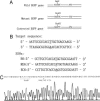Increased efficiency of oligonucleotide-mediated gene repair through slowing replication fork progression
- PMID: 15695590
- PMCID: PMC548982
- DOI: 10.1073/pnas.0406991102
Increased efficiency of oligonucleotide-mediated gene repair through slowing replication fork progression
Abstract
Targeted gene modification mediated by single-stranded oligonucleotides (SSOs) holds great potential for widespread use in a number of biological and biomedical fields, including functional genomics and gene therapy. By using this approach, specific genetic changes have been created in a number of prokaryotic and eukaryotic systems. In mammalian cells, the precise mechanism of SSO-mediated chromosome alteration remains to be established, and there have been problems in obtaining reproducible targeting efficiencies. It has previously been suggested that the chromatin structure, which changes throughout the cell cycle, may be a key factor underlying these variations in efficiency. This hypothesis prompted us to systematically investigate SSO-mediated gene repair at various phases of the cell cycle in a mammalian cell line. We found that the efficiency of SSO-mediated gene repair was elevated by approximately 10-fold in thymidine-treated S-phase cells. The increase in repair frequency correlated positively with the duration of SSO/thymidine coincubation with host cells after transfection. We supply evidence suggesting that these increased repair frequencies arise from a thymidine-induced slowdown of replication fork progression. Our studies provide fresh insight into the mechanism of SSO-mediated gene repair in mammalian cells and demonstrate how its efficiency may be reliably and substantially increased.
Figures






Similar articles
-
Improvement of SSO-mediated gene repair efficiency by nonspecific oligonucleotides.Biochem Biophys Res Commun. 2008 Nov 7;376(1):74-9. doi: 10.1016/j.bbrc.2008.08.119. Epub 2008 Sep 2. Biochem Biophys Res Commun. 2008. PMID: 18771655
-
The involvement of replication in single stranded oligonucleotide-mediated gene repair.Nucleic Acids Res. 2006;34(21):6183-94. doi: 10.1093/nar/gkl852. Epub 2006 Nov 6. Nucleic Acids Res. 2006. PMID: 17088285 Free PMC article.
-
Single-stranded oligonucleotide-mediated gene repair in mammalian cells has a mechanism distinct from homologous recombination repair.Biochem Biophys Res Commun. 2006 Nov 24;350(3):568-73. doi: 10.1016/j.bbrc.2006.09.078. Epub 2006 Sep 26. Biochem Biophys Res Commun. 2006. PMID: 17026965
-
Oligonucleotide-mediated gene repair at DNA level: the potential applications for gene therapy.J Mol Med (Berl). 2002 Oct;80(10):620-8. doi: 10.1007/s00109-002-0366-y. Epub 2002 Aug 28. J Mol Med (Berl). 2002. PMID: 12395146 Review.
-
Regulation of DNA replication during the cell cycle: roles of Cdc7 kinase and coupling of replication, recombination, and repair in response to replication fork arrest.IUBMB Life. 2000 May;49(5):353-64. doi: 10.1080/152165400410191. IUBMB Life. 2000. PMID: 10902566 Review.
Cited by
-
Oligonucleotide delivery by nucleofection does not rescue the reduced proliferation phenotype of gene-edited cells.Nucleic Acid Ther. 2012 Dec;22(6):405-13. doi: 10.1089/nat.2012.0374. Epub 2012 Oct 16. Nucleic Acid Ther. 2012. PMID: 23072627 Free PMC article.
-
Strand bias influences the mechanism of gene editing directed by single-stranded DNA oligonucleotides.Nucleic Acids Res. 2011 Jun;39(11):4783-94. doi: 10.1093/nar/gkr061. Epub 2011 Feb 22. Nucleic Acids Res. 2011. PMID: 21343181 Free PMC article.
-
Manipulation of cell cycle progression can counteract the apparent loss of correction frequency following oligonucleotide-directed gene repair.BMC Mol Biol. 2007 Feb 6;8:9. doi: 10.1186/1471-2199-8-9. BMC Mol Biol. 2007. PMID: 17284323 Free PMC article.
-
Mechanisms of precise genome editing using oligonucleotide donors.Genome Res. 2017 Jul;27(7):1099-1111. doi: 10.1101/gr.214775.116. Epub 2017 Mar 29. Genome Res. 2017. PMID: 28356322 Free PMC article.
-
Efficiency of genome editing using modified single-stranded oligodeoxyribonucleotides in human cells.Sci Rep. 2025 Mar 21;15(1):9764. doi: 10.1038/s41598-025-94071-5. Sci Rep. 2025. PMID: 40119107 Free PMC article.
References
Publication types
MeSH terms
Substances
LinkOut - more resources
Full Text Sources
Other Literature Sources

